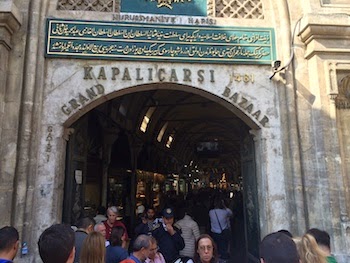 |
| An Entrance to the Grand Bazaar |
One of the most famous attractions of Istanbul is the Grand Bazaar, and it’s been at (or near) the top of our wanna-see list for quite some time. It’s a sight to behold, to be certain, but Istanbul is brimming with bazaars and markets.
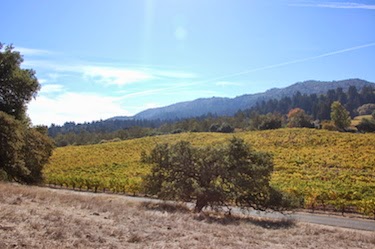 |
| The Grand Bazaar |
The Grand Bazaar
This is the mack-daddy of all bazaars, and not just the bazaars of Istanbul. With more than 5,000 shops in a maze of arch-covered shopping glory, the Grand Bazaar is more a city-within-a-city than a marketplace. It’s so large that it’s roughly grouped into merchant clusters, with a concentration of jewelry shops here, a group of leather shops there. Even then, the shops spill out of the confines of the covered buildings and into the surrounding streets. We found the antique section particularly interesting, and the shops selling Turkish lamps–those colorful glass mobiles–are wonderfully dispersed around the whole bazaar. There are, naturally, Turkish carpet stores everywhere, so many that you wonder how they can stay in business: there must be a healthy supply of tourists willing to shell out a couple grand or more on those artistic carpets.
Being such a top destination, the Grand Bazaar is jam-packed with tourists and cruise ship groups following guides with signs on sticks or umbrellas held high. In some places, the crowds are shoulder-to-shoulder. And you can tell by the lack of locals that the prices are at touristic premiums. For the sheer frenetics of the place, the hustle-and-bustle of sights and sounds, you can’t miss the Grand Bazaar. But if you are looking to actually buy something, keep reading.
 |
| An Entrance to the Egyptian Spice Bazaar |
The Egyptian Spice Bazaar
Less than half a mile almost due north of the Grand Bazaar, close to the shores of the Bosphorus at the southern landing of the Galata Bridge, you’ll find the Egyptian Spice Bazaar. According to Google Maps, and closer to reality, it’s simply the Egyptian Bazaar: its specialization as a spice bazaar is long gone.
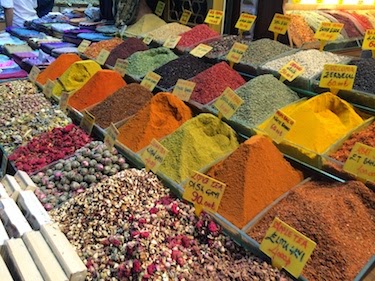 |
| Spice Vendor at the Egyptian Bazaar |
That’s not to say there are no spice vendors here: there are in fact, plenty of them. But you can find spice vendors aplenty at any bazaar and spread around the city. Likewise there are lots of carpet, tile, jewelry, and more vendors to be found here as well.
The advantage of the Egyptian Bazaar is that it’s a slightly more manageable size–not nearly as easy to get lost in–and one step down the tourist destination lists from the Grand Bazaar. You’d think that would mean less tourists, but we found it as packed here as at the Grand Bazaar, though perhaps with more foodies than tour group shoppers looking for nonexistent deals.
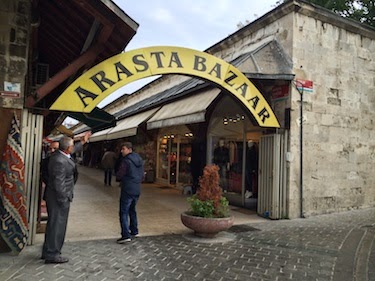 |
| A Fine Alternative Bazaar: Arasta |
The Arasta Bazaar
There are, in fact, bazaars all over Istanbul. Unlike the Grand Bazaar, they are usually open air, pedestrian-only stretches lined with the same type of shops you’ll find at the Grand Bazaar and the Egyptian Bazaar. Not being on the tour circuit, they are usually–and wonderfully–less trafficked. This actually could be a disadvantage: without the crowds, the store hawkers–those guys tasked with getting you into their stores and spending your money–are more likely to hit you up than in the overcrowded bazaars. But we also found the hawkers in these quieter bazaars more polite and laid-back than their cousins at the Grand Bazaar.
 |
| The Wonderfully Quiet Promenade of the Arasta Bazaar |
You don’t have to go out of your way to find these other bazaars. One such is the Arasta Bazaar. If you come to Istanbul, the Sultanahmet (“Blue”) Mosque is going to be on your must-see list, and the Arasta Bazaar is all-too-conveniently located just east of the mosque. It’s a single stretch of a hundred or so shops, a quieter, more relaxed experience than the “big” bazaars. Consider spending some time here the same day you visit the Blue Mosque, but as it’s in the midst of the Sultanahmet tourist zone, don’t expect too much of an improvement on the prices.
 |
| Street Shops in Istanbul |
Istanbul’s Bargain District
For great deals, with prices and bargains that attract the locals, you only have to stroll the streets between the big tourist bazaars. In particular, spend some time in the maze of streets to the south (and up the hill) of the Egyptian Spice Bazaar. If you’re coming from the Sultanahmet/Topkapi area, it’s the pedestrian-mainly streets (the full concept of “pedestrian-only” doesn’t seem to exist in Turkey, so be on guard for cars and scooters weaving through the crowds) a half mile west of the Topkapi Palace and Gulhane Park.
You’ll find a totally different vibe here, and you’ll feel like you’re in a foreign country. People aren’t wandering around with cameras and following someone with an umbrella: they know where they’re going and they’re busy. Men sell snacks from trays they carry on their heads, they push and pull big carts making deliveries, and even carry huge packages on their backs. The hawkers are more likely to chat and joke with you, the food vendors are tasty and quick, and the prices are better than at the bazaars. Chuck bought a tux jacket and pants for less than $100 here.
 |
| Delivery Man |
The variety of shops doesn’t suffer here. You’ll still find spice vendors, Turkish lamp shops, silver and jewelry stores, carpet shops, and more, but they’re setup to appeal to the locals. And among them you’ll also find the kinds of shops that the locals need, like kitchen goods, plumbing supplies, restaurant supplies, underwear and (even) lingerie stores, lace and bridal shops, and children’s apparel…that is, if you want your children dressed like little sultans.
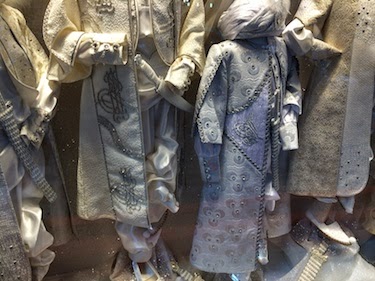 |
| Children’s Clothing Store, Istanbul Style |






